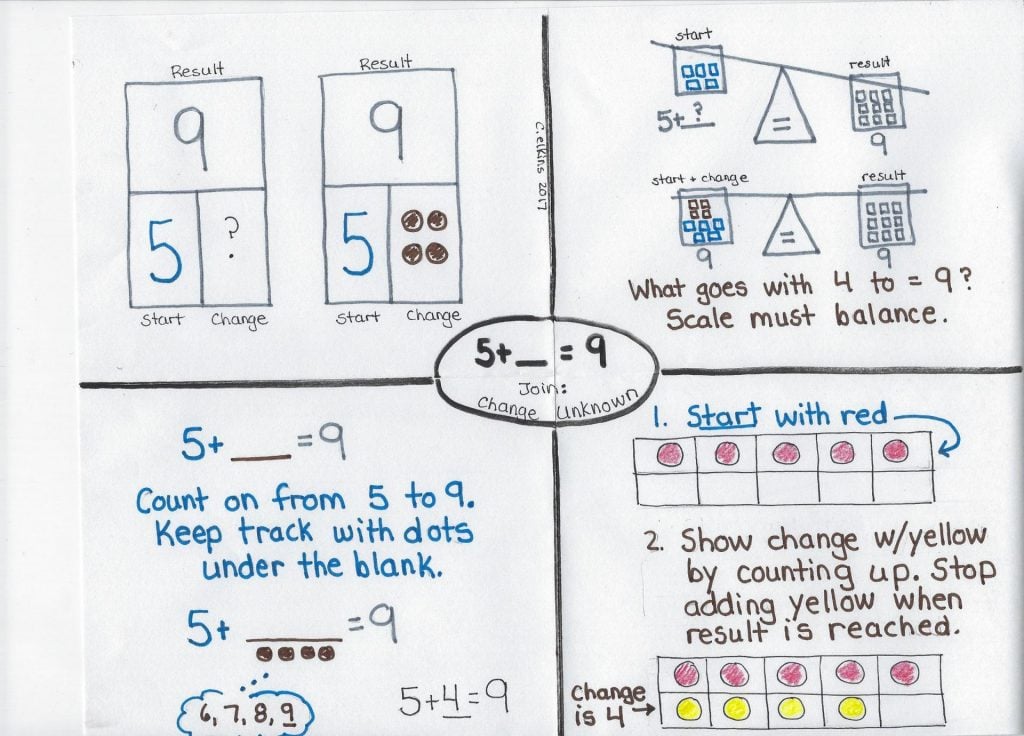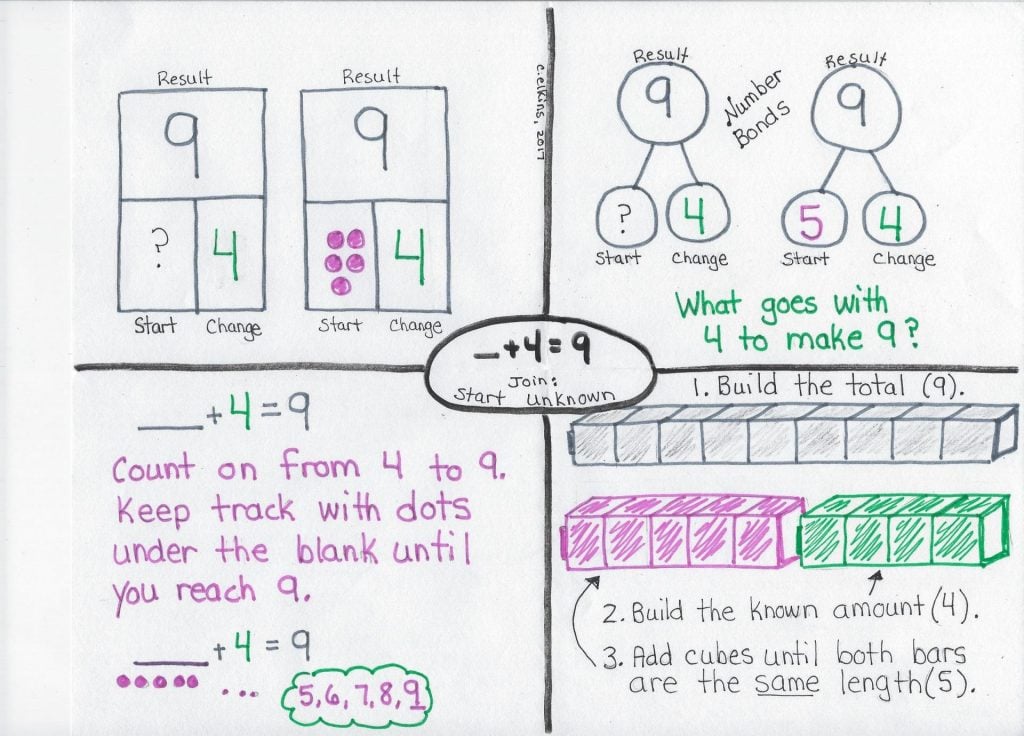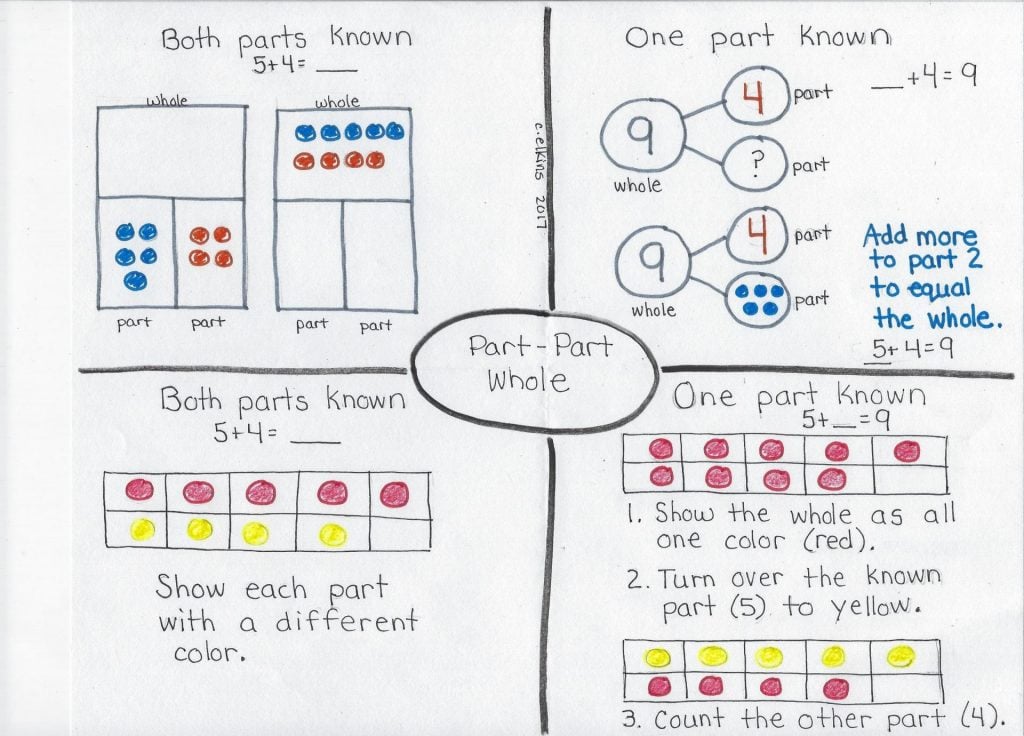by C. Elkins, OK Math and Reading Lady
Ask your students this question: “What does the equal sign mean?” I venture many or most of them will say, “It’s where the answer goes,” or something to that effect. You will see them apply this understanding with the type of problem in which the answer blank comes after the equal sign such as in 5 + 6 = _____ or 14 – 9 = _____. This is the most common type of problem structure called Result Unknown. I was guilty of providing this type of equation structure a majority of the time because I didn’t know there actually were other structures, and I didn’t realize the importance of teaching students the other structures. So . . . here we go. (Be sure to look for freebies ahead.)
Teach your students the equal sign means “the same as.” Think of addition and subtraction problems as a balance scale: what’s on one side must be the same as the other side — to balance it evenly.
Let’s look at the equal sign’s role in solving the different addition / subtraction structures. I will be using the words start to represent how the problem starts, the word change to represent what happens to the starting amount (either added to or subtracted), and the result. In this post I will be addressing the join / addition models of Result Unknown, Change Unknown, Start Unknown and Part-Part-Whole. I will highlight the subtraction models (Separate and Comparison) next time. Knowing these types of structures strengthens the relationship between addition and subtraction.
Three of these addition models use the term join because that is the action taken. There are some, then some more are joined together in an additive model. One addition model, however, is the part-part-whole model. In this type there is no joining involved – only showing that part of our objects have this attribute and the other part have a different attribute (such as color, type, size, opposites).
Helpful materials to teach and practice these strategies are bar models, part whole templates, a balance scale, and ten frames using cubes and/or two color counters. Here are 2 free PDF attachments. First one: Addition and Subtraction Story Structure Information. Second one is a copy of each of the 4 anchor charts shown below: Join and part-part-whole story structure anchor charts
Join: Result Unknown
- Example: 5 + 4 = ____; A boy had 5 marbles and his friend gave him 4 more marbles. How many marbles does the boy have now?
- Explanation: The boy started with 5 marbles. There was a change in the story because he got 4 more. The result in this problem is the action of adding the two together.
- Teaching and practice suggestions:

- Ask questions such as: Do we know the start? (Yes, it is 5.) Do we know what changed? (Yes, his friend gave him more, so we add 4.) What happens when we put these together?(Result is 9.)
- Show the problem in this order also (with result blank first instead of last) : ____ = 5 + 4
- Common questions: How many now? How many in all? How many all together? What is the sum?
Join: Change Unknown
- Example: 5 + ____ = 9; A boy had 5 marbles. His friend gave him some more. Now he has 9 marbles. How many marbles did his friend give him? You could also call this a missing addend structure.
- Explanation: This problem starts with 5. There is a change of getting some more marbles, but we don’t know how many yet. The result after the change is (9). It is very likely students will solve like this: 5 + 14 = 9. Why? Because they see the equal sign and a plus sign and perform that operation with the 2 numbers showing. Their answer of 14 is put in the blank because of their misunderstanding of the meaning of the equal sign.
- Teaching and practice suggestions:

- Ask questions such as: Do we know the start? (Yes, he started with 5 marbles.) Do we know what changed in the story? (Yes, his friend gave him some marbles, but we don’t know how many.) Do we know the result? (Yes, he ended up with 9 marbles.) So the mystery is “How many marbles did his friend give him?”
- Count up from the start amount to the total amount. This will give you the change involved in the story.
- Reinforce number bonds by asking, “What goes with 5 to make 9?” or “What is the difference between 5 and 9?”
Join: Start Unknown
- Example: ____ + 4 = 9; A boy had some marbles. His friend gave him 4 more. Now he has 9. How many did he have to start with?
- Explanation: The boy had some marbles to start with, but the story does not tell us. Then there is a change in the story when his friend gives him some more (4). The result is that he has 9.
- Teaching and practice suggestions:

- Ask questions such as: Do we know how many marbles the boy started with? (No, the story didn’t tell us.) Do we know what changed in the story? (Yes, his friend have him 4 marbles.) Do we know the result? (Yes, he had 9 marbles at the end.)
- Count up from 4 to 9.
- Reinforce knowledge of number bonds by asking, “What goes with 4 to make 9?”
Part-Part Whole: These problems and solutions will resemble the above structures, but the content of the stories show a part-part-whole relationship usually featuring the same object, but different colors, sizes, types, etc. There is no change involved in part–part-whole story models — only telling how one part differs from the other part. Examples: Part of the pencils are sharp, the other part are dull. Part of the apples are red, part of them are green. Part of the kids are girls, the other part are boys. Part of the crayons are in the basket, part of them are out of the basket.
- Examples:
- 5 + 4 = ____; I have a basket of apples. 5 are red and 4 are green. How many apples all together?
- 5 + ___ = 9; I have a basket of apples. 5 are red and the rest are green. There is a total of 9. How many are green?
- ___ + 4 = 9; I have a basket of apples. Some of them are red. 4 of them are green. There are a total of 9. How many are red?
- Teaching and practice suggestions:

- Use part-part-whole models, ten frames with 2 color counters, and connecting cubes.
- If both parts are known, combine them to find the whole.
- If one part is known, use the change unknown or start unknown model. (Count up from known to whole).
- Reinforce knowledge of known number bonds. What goes with 5 to make 9?
Brainstorm words/verbs that indicate a joining or additive process is taking place. Make a chart in the room which can be referred and added to as you explore new problems. Here are some ideas: come, join, find/found, given, buy/bought, received, ran in, walked in, flew in, earned, cooked, put, etc.
Key Words Misconception
Be careful about teaching “key word” strategies such as “Add if the question asks how many in all.” Children are likely to only see this type of question in a result unknown structure, but not in a change unknown or start unknown model. Even consider the part-part-whole model above. The second questions asks, “How many are green?” Would the child add 5 + 9 together when they should be thinking of what goes with 5 to make 9 or performing a subtraction operation? If we are strictly teaching kids to just look at the question, then they are often missing the content of the story and lose sight of how the story starts and the change shown in the story. Again, I made all of these same mistakes . . . just helping you see the light too!!
FREEBIE: Go to one of my favorite math resources on TPT (math coachs corner – Donna Boucher) or www.mathcoachscorner.com. She has some good activities on this topic.
I will focus on the subtraction side of problem solving next time with these structures: Separate, Comparison. and Part-Part-Whole
Got questions or concerns? Let me know. Click the comment speech bubble at the top.